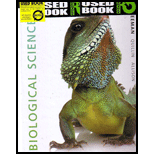
Choose the best definition of a fossil.
a. any trace of an organism that has been converted into rock
b. a bone, tooth, shell, or other hard part of an organism that has been preserved
c. any trace of an organism that lived in the past
d. the process that leads to preservation of any body part from an organism that lived in the past
Introduction:
The fossils are defined as the remains of organisms that were preserved and embedded in the earth. They are studied for their age, formation process, and significance in evolution. The study of the fossil is called paleontology and the totality of fossil is termed as fossil records.
Answer to Problem 1TYK
Correct answer:
The preserved remains or traces of any part or whole of an organism that was once living, are called fossils by the process of fossilization. The hard parts of the body, such as teeth and bones do not decompose easily and get preserved in the rocks or soil.
Explanation of Solution
Justification for the correct answer:
Option (c) is given as any organism traces that lived in the past. The fossils show preserved remains of prehistoric organisms (organisms that were present in the periods of earth history). They provide information about the organisms that once lived in the past. Hence, option (c) is correct.
Justification for the incorrect answers:
Option (a) is given as any organism’s traces that are converted into rocks. Fossils get embedded in rocks and they are not converted into rocks. So, it is an incorrect option.
Option (b) is given as any hard parts that have been preserved. Soft parts of the organisms that are preserved can also be considered as fossilized remains, such as fossils of casts and molds as impressions of their superficial in rocks. So, it is an incorrect option.
Option (d) is given as the process that leads to preservation of any part of from an organism that lived in the past. This process of preservation of organism is called fossilization, not fossil. So, it is an incorrect option.
Hence, options (a), (b), and (d) are incorrect.
Thus, it can be concluded that a fossil is any part of the dead organism that has been preserved, which lived in the past.
Want to see more full solutions like this?
Chapter 28 Solutions
Biological Science
- Noggin mutation: The mouse, one of the phenotypic consequences of Noggin mutationis mispatterning of the spinal cord, in the posterior region of the mouse embryo, suchthat in the hindlimb region the more ventral fates are lost, and the dorsal Pax3 domain isexpanded. (this experiment is not in the lectures).a. Hypothesis for why: What would be your hypothesis for why the ventral fatesare lost and dorsal fates expanded? Include in your answer the words notochord,BMP, SHH and either (or both of) surface ectoderm or lateral plate mesodermarrow_forwardNot part of a graded assignment, from a past midtermarrow_forwardNot part of a graded assignment, from a past midtermarrow_forward
- please helparrow_forwardWhat does the heavy dark line along collecting duct tell us about water reabsorption in this individual at this time? What does the heavy dark line along collecting duct tell us about ADH secretion in this individual at this time?arrow_forwardBiology grade 10 study guidearrow_forward
 Concepts of BiologyBiologyISBN:9781938168116Author:Samantha Fowler, Rebecca Roush, James WisePublisher:OpenStax College
Concepts of BiologyBiologyISBN:9781938168116Author:Samantha Fowler, Rebecca Roush, James WisePublisher:OpenStax College
 Human Biology (MindTap Course List)BiologyISBN:9781305112100Author:Cecie Starr, Beverly McMillanPublisher:Cengage Learning
Human Biology (MindTap Course List)BiologyISBN:9781305112100Author:Cecie Starr, Beverly McMillanPublisher:Cengage Learning Biology Today and Tomorrow without Physiology (Mi...BiologyISBN:9781305117396Author:Cecie Starr, Christine Evers, Lisa StarrPublisher:Cengage Learning
Biology Today and Tomorrow without Physiology (Mi...BiologyISBN:9781305117396Author:Cecie Starr, Christine Evers, Lisa StarrPublisher:Cengage Learning Biology (MindTap Course List)BiologyISBN:9781337392938Author:Eldra Solomon, Charles Martin, Diana W. Martin, Linda R. BergPublisher:Cengage Learning
Biology (MindTap Course List)BiologyISBN:9781337392938Author:Eldra Solomon, Charles Martin, Diana W. Martin, Linda R. BergPublisher:Cengage Learning Biology: The Dynamic Science (MindTap Course List)BiologyISBN:9781305389892Author:Peter J. Russell, Paul E. Hertz, Beverly McMillanPublisher:Cengage Learning
Biology: The Dynamic Science (MindTap Course List)BiologyISBN:9781305389892Author:Peter J. Russell, Paul E. Hertz, Beverly McMillanPublisher:Cengage Learning





